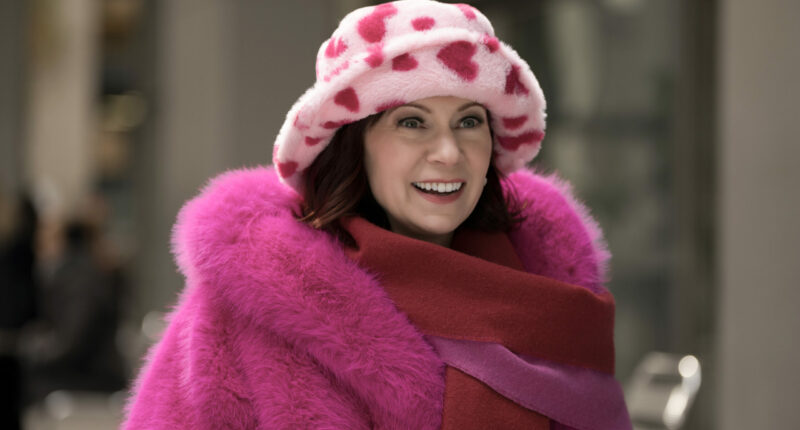Carrie Preston, beloved for her quirky roles in The Good Wife and now leading CBS’s Elsbeth, recently shared a personal health update that resonates far beyond Hollywood. While filming the hit procedural series, she received an unexpected diagnosis—basal cell carcinoma, a common yet often underestimated form of skin cancer. What began as a small, seemingly harmless spot on her face turned out to be a wake-up call not just for the actress, but for anyone who may be overlooking subtle changes in their skin.
Her story is a powerful reminder that skin cancer can affect anyone, regardless of age, fame, or lifestyle. Often dismissed as a “less serious” cancer, basal cell carcinoma can still cause serious complications if ignored. Preston’s openness about her experience shines a light on the importance of early detection, sun protection, and regular skin checks.

In this article, we’ll unpack Carrie Preston’s diagnosis, explain what basal cell carcinoma really is, identify early symptoms you shouldn’t ignore, look at the treatment options available, and offer practical steps to help reduce your risk. Whether you’re familiar with skin cancer or learning about it for the first time, this is information everyone should know.
Carrie Preston Learned She Had Skin Cancer While Filming Elsbeth
Carrie Preston, known for her award-winning role in The Good Wife and more recently as the star of CBS’s Elsbeth, recently shared a deeply personal health revelation. While immersed in filming the crime procedural series, the 56-year-old actress received a diagnosis that took her by surprise—basal cell carcinoma, the most common form of skin cancer.
In a heartfelt interview, Preston recalled how the discovery began with what seemed like a minor spot on her face, easily overlooked amidst the chaos of shooting scenes and long production days. Her makeup team noticed a persistent blemish on her nose that wasn’t healing, prompting her to consult a dermatologist. What followed was both alarming and enlightening. The diagnosis not only altered her schedule but also her perspective on skin health and early detection.
“I’m incredibly fortunate it was caught early,” she said. “It’s easy to ignore something so small until it becomes something so big.”
Preston’s story is not unique. Her experience mirrors what thousands silently endure each year—many without ever realizing they’re at risk.
What Is Basal Cell Carcinoma—and Why It’s So Common
Basal cell carcinoma (BCC) accounts for approximately 80% of all skin cancer diagnoses, according to the American Cancer Society. It originates in the basal cells, which are found in the lowest layer of the epidermis. While this form of skin cancer typically grows slowly and rarely spreads, it can cause disfigurement or damage to surrounding tissues if left untreated.
Most BCCs appear on sun-exposed areas such as the face, ears, neck, scalp, and shoulders. Though they often manifest in older adults, increasing cases are now seen in younger individuals, especially those with a history of intense sun exposure or tanning bed use.
Despite its prevalence, BCC is often underestimated due to its non-aggressive nature. However, early detection is key. When diagnosed early, nearly 100% of BCC cases can be successfully treated.
Early Skin Cancer Symptoms To Watch For—Don’t Ignore These Signs
Identifying skin cancer in its early stages dramatically improves treatment outcomes. That said, basal cell carcinoma may not always present in ways people expect. Carrie Preston, for instance, mistook her skin lesion for a breakout or irritated patch of skin.
Here are common warning signs associated with basal cell carcinoma:
- A shiny bump or nodule that is pearly or translucent (especially in fair-skinned individuals)
- A flat, flesh-colored or brown scar-like lesion
- A sore that doesn’t heal, bleeds easily, or repeatedly returns
- Pink growths with a slightly raised, rolled border and crusted indentation in the center
- Red patches that may itch or hurt
It’s important to remember that BCC is not painful in many cases, which often leads to delays in seeking medical attention. If a skin change lasts more than a few weeks, it warrants evaluation by a dermatologist.
How Basal Cell Carcinoma Is Treated—Options That Work
Treatment for basal cell carcinoma varies depending on the location, size, depth, and subtype of the tumor, as well as the patient’s medical history. Fortunately, advancements in dermatologic procedures offer multiple effective options, most of which are outpatient-based.
Common treatments include:
- Surgical excision – The tumor is cut out along with a margin of healthy tissue.
- Mohs surgery – A specialized technique where layers are removed and examined under a microscope until no cancer cells remain. It’s often used for facial BCCs due to its tissue-sparing benefits.
- Curettage and electrodessication – Scraping away cancerous tissue followed by cauterization.
- Topical therapies – Prescription creams like imiquimod for superficial BCCs.
- Radiation therapy – Used when surgery isn’t an option.
- Targeted drug therapy or immunotherapy – Reserved for advanced or recurrent cases.
Preston underwent surgical removal, which she described as “quick and precise,” allowing her to return to work after a brief recovery.
Preston Is Recovering From Skin Cancer Surgery—and She’s Advocating for Awareness
Carrie Preston’s skin cancer diagnosis could have gone unnoticed had her team not spoken up. That moment underscores the importance of being aware of your own skin and listening when others notice changes. She took to social media to share her recovery process and used the opportunity to urge fans to wear sunscreen and schedule regular skin checks.
“I’m wearing SPF every day now—not just when I’m at the beach,” she shared in a post that quickly went viral. “Your skin remembers every sunburn you’ve ever had.”
She’s also credited her Elsbeth team for encouraging a positive work environment during her treatment, allowing her to manage her health without fear of professional setbacks.
How To Prevent Skin Cancer—Protect Your Skin for Life
Although skin cancer is the most commonly diagnosed cancer worldwide, it’s also one of the most preventable. Practicing sun safety can drastically reduce your risk of developing BCC and other skin cancers.
Smart prevention strategies include:
- Apply broad-spectrum sunscreen with SPF 30 or higher daily, even on cloudy days.
- Avoid peak sun hours between 10 a.m. and 4 p.m. when UV rays are strongest.
- Wear protective clothing, hats, and sunglasses.
- Stay out of tanning beds—they significantly increase your risk of skin cancer.
- Examine your skin monthly for changes in moles, spots, or new growths.
- See a dermatologist annually for a full-body skin exam.
According to the Skin Cancer Foundation, using sunscreen regularly can lower your risk of BCC by about 40%, and regular skin checks increase the likelihood of catching it early—when it’s easiest to treat.
Final Thoughts: Why Carrie Preston’s Story Matters
Carrie Preston’s candid revelation is more than a celebrity health update—it’s a timely reminder that skin cancer doesn’t discriminate based on age, status, or schedule. It often begins with something small, but when addressed early, it doesn’t have to define your life.
Her willingness to speak out shines a spotlight on prevention, early detection, and the quiet courage it takes to prioritize one’s health—especially under the glare of public life. Whether you’re in front of the camera or behind a desk, Preston’s story proves that a little vigilance can save your skin—literally.
Also Read | Rock Legend Ozzy Osbourne Dies at 76 From Parkinson’s









